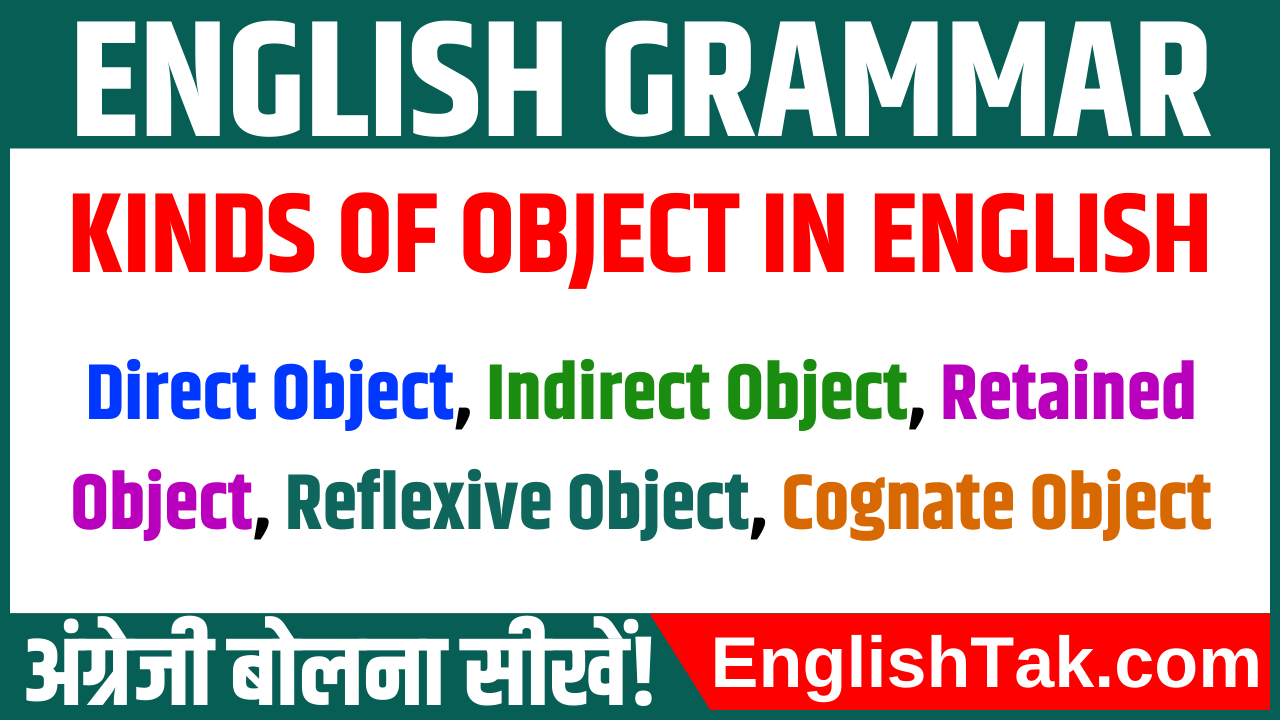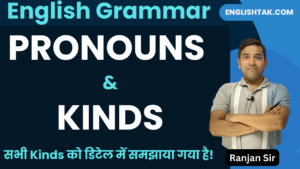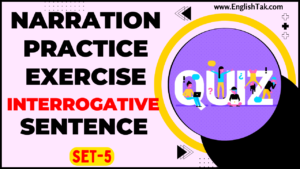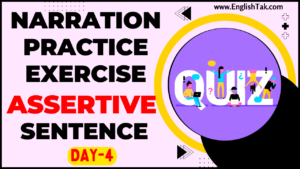![]()
Kinds of Object in English
Table of Contents
Kinds of Object in English:- In this Post, you will learn all Kinds of Object in English Grammar. Through this blog, I have tried my level best to make it easy to Understand.
As you know, An object plays a very important role in the English language. Try Understanding it completely.
Types of Object in English Grammar
Object निम्नलिखित पांच प्रकार के होते हैं –
(1) Direct Object
(2) Indirect Object
(3) Retained Object
(4) Reflexive Object
(5) Cognate Object
(1) Direct Object
Definition – A direct object in English refers to the noun, pronoun, or noun phrase that directly receives the action of a verb in a sentence. It answers the question “Whom?” or “What?”
Action को Receive करने वाला चाहे वो कोई व्यक्ति हो या वस्तु हो Direct Object कहलाता है। ध्यान रहे की किसी Sentence में अगर सिर्फ एक Object रहे तो वह हमेशा Direct Object कहलाता है, चाहे वह कोई व्यक्ति हो या वस्तु।
Examples –
(1) I teach you. – मैं आपको पढ़ाता हूँ।
(2) I teach English. – मैं अँग्रेजी पढ़ता हूँ।
Note:- पहले वाक्य में You तथा दूसरे वाक्य में English, Direct Object हैं, क्योंकि ये दोनों किसी व्यक्ति या वस्तु को सूचित करते हैं और ये Noun या Pronoun हैं।
(2) Indirect Object
Definition – An indirect object in English refers to the noun, pronoun, or noun phrase that indicates to whom or for whom the action of a verb is done. It usually appears between the verb and the direct object and answers the question “To whom?” or “For whom?” It provides additional information about the recipient or beneficiary of the action.
जब किसी Sentence में दो Objects हो तो Whom का Answer देने वाला Indirect Object कहलाता है। यह साधरणतः Verb और Direct Object के बीच में आता है।
Examples –
(1) My father gives me money.
मेरे पिताजी मुझे पैसे देते हैं।
(2) I teach them English.
मैं उन्हें अंग्रेजी पढ़ाता हूं।
पहले वाक्य में me तथा दूसरे वाक्य में them, Indirect object हैं क्योंकि ये दोनों Whom से पूछे गए प्रश्न का जवाब देते है, और ये pronoun भी हैं।
Examples –
(1) Rohan sent me a parrot.
रोहन ने मुझे एक तोता भेजा।
(2) I gave the door a push.
मैंने दरवाजे को धक्का दिया।
पहले वाक्य में Verb “Sent” के दो Objects – me और parrot है। What से प्रश्न पूछने पर Parrot जवाब आएगा अतः यह Direct Object होगा और Whom से प्रश्न पूछने पर Me जवाब आएगा अतः यह Indirect Object होगा।
दूसरे वाक्य में Verb “Gave” के दो Objects “Door” और “Push” है। What से प्रश्न पूछने पर Push जवाब आएगा अतः यह Direct Object होगा और Whom से प्रश्न पूछने पर Door जवाब आएगा अतः यह Indirect Object होगा।
NOTE:- यहाँ एक बात मैं Clear कर देना चाहता हूँ कि English Language में सजीव या निर्जीव Object होता ही नहीं है। अर्थात YouTube Video या किसी Website पर ये सब पढ़ कर अपना Concepts खराब न करें।
(3) Retained Object
Definition – A “Retained Object” refers to the object in a sentence whose position remains unchanged even when the sentence undergoes a transformation from active to passive voice, or from passive to active voice.
वाक्य के रूपांतरण अर्थात Active से Passive या Passive से Active voice में Transformation के बाद भी जिस Object का Position नहीं बदलता है, उस Object को Retained Object कहा जाता है।
Examples –
(1) Rohan taught him English. (Active)
रोहन उसे अंग्रेजी पढ़ाया।
(2) He was taught English by Rohan. (Passive)
उसे रोहन के द्वारा अंग्रेजी पढ़ाया गया था।
पहले Sentence में Verb “Taught” के दो Objects हैं – Him और English.
Sentence 1 में दो Objects है; Him जो की Whom से प्रश्न पूछने पर Answer मिलता है, Indirect Object है। जबकि What से प्रश्न पूछने पर जवाब मिलता है English इसलिए English – Direct Object है।
दूसरे वाक्य (passive) में taught क्रिया का object – English है। English direct object है।
ध्यान दीजिए! वाक्य को Active Form से Passive Form में बदलने पर भी English – Direct Object के रूप में ही प्रयुक्त हुआ है। इसलिए English – Retained Object है।
(4) Reflexive Object
Definition – “When a reflexive pronoun is used as the object in a sentence, it is referred to as a reflexive object.”
जब Reflexive Pronoun का प्रयोग Object की तरह होता है तो उसे Reflexive Object कहा जाता है।
Examples –
(1) He hanged himself.
उसने खुद को फांसी लगा ली।
(2) They enjoyed themselves in the party.
उन्होंने पार्टी में खूब एन्जॉय किया।
इन दोनों वाक्यों में प्रयुक्त – himself और themselves दोनों Reflexive Pronouns हैं। इनका प्रयोग Object की तरह हुआ है। इसलिए himself और Themselves दोनों Reflexive Objects हैं।
(5) Cognate Object
Definition – The object whose meaning is contained in the verb used before it, is called Cognate Object.
A cognate object is a grammatical term used to describe a specific type of direct object in a sentence. It refers to an object that shares the same root or linguistic origin as the verb used in the sentence. This means that the object and the verb are related in terms of their etymology or meaning.
जिस object का अर्थ उसके पूर्व प्रयुक्त क्रिया में निहित हो, Cognate Object कहलाता है।
Examples –
(1) He slept a troubled sleep. (He slept, and his sleep was troubled.)
वह परेशान नींद सोया।
(2) He laughed a bitter laugh. (He laughed bitterly.)
वह फूट फूट कर हँसे।
पहले वाक्य में Verb – Sleep का object – A troubled sleep है। Sleep का अर्थ Troubled sleep क्रिया में निहित है। इसलिए इस वाक्य का Object – ‘A troubled sleep’ – Cognate Object है।
दूसरे वाक्य में Object – ‘A bitter laugh’ है। Laugh का अर्थ कुछ हद तक A bitter laugh क्रिया में निहित है। इसलिए इस वाक्य का Object – ‘A bitter laugh’– Cognate Object है।
Some Other Examples:-
She dreamed a strange dream. (She dreamed, and her dream was strange.)
He walked their walk and talked their talk. (He walked and talked as they did.)
She smiled a charming smile. (She smiled, and her smile was charming.)
He danced a cheerful dance. (He danced, and his dance was cheerful.)
She died a painful death. (She died painfully.)
Learn English Grammar in Hindi
Common Adjectives with Letter E
SSC CGL Previous Year Cloze Test
A dialogue between a housewife and a hawker
SSC CGL Cloze Test with Answer
45 Examples of Present Perfect Continuous
Top 50 Daily Use Sentences – Day-29





